Posted by kavery508 | Posted in Uncategorized | Posted on November 13, 2017
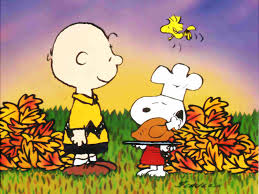 Thanksgiving Week Changes: There will be no math and reading homework next week. There is a math facts quiz on Tuesday, to help students try to level up, so quizzes and flash cards will come home this Friday. Also next week, our blog will be taking a break for Thanksgiving. I hope you and your family have much to be thankful for this year, and I wish you the happiest of holidays!
Thanksgiving Week Changes: There will be no math and reading homework next week. There is a math facts quiz on Tuesday, to help students try to level up, so quizzes and flash cards will come home this Friday. Also next week, our blog will be taking a break for Thanksgiving. I hope you and your family have much to be thankful for this year, and I wish you the happiest of holidays!
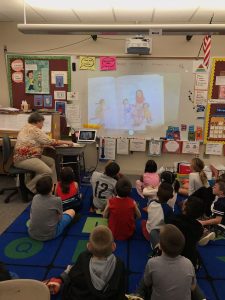 Our thanks go out to the Rotary Club of Shrewsbury! We were presented with a gift of 3 classroom books from Rotarian Mrs. Deane, a retired teacher herself! Mrs. Deane engaged students with a Q & A about the clubs good works, and read from the books we were given. We are grateful indeed.
Our thanks go out to the Rotary Club of Shrewsbury! We were presented with a gift of 3 classroom books from Rotarian Mrs. Deane, a retired teacher herself! Mrs. Deane engaged students with a Q & A about the clubs good works, and read from the books we were given. We are grateful indeed.
 Our CAFE focus this week is on Stop, Think, Paraphrase (STP). This year, students are learning to think about the text before, during, and after reading. This strategy is designed to get them to think about what was important information on each page they read. After reading a page, students should pause to reflect and summarize the important information in a sentence or two. It’s especially helpful when reading nonfiction, to help them understand the main idea and supporting details put forth by the author. Kids can practice at home with articles from Time for Kids and Sports Illustrated Kids! In the case of online articles, STP can be used after paragraphs.
Our CAFE focus this week is on Stop, Think, Paraphrase (STP). This year, students are learning to think about the text before, during, and after reading. This strategy is designed to get them to think about what was important information on each page they read. After reading a page, students should pause to reflect and summarize the important information in a sentence or two. It’s especially helpful when reading nonfiction, to help them understand the main idea and supporting details put forth by the author. Kids can practice at home with articles from Time for Kids and Sports Illustrated Kids! In the case of online articles, STP can be used after paragraphs.
 Our work with bar modeling is paying off! Students are becoming adept at relating them to parts-and-total problems, using them to make sense of problems, and understanding numbers involved by drawing them bars with appropriate scale. This week we are learning to use bar models to make sense of comparison problems. The model looks different from before because our thinking about solving the problem should be different. For example, consider this problem:
Our work with bar modeling is paying off! Students are becoming adept at relating them to parts-and-total problems, using them to make sense of problems, and understanding numbers involved by drawing them bars with appropriate scale. This week we are learning to use bar models to make sense of comparison problems. The model looks different from before because our thinking about solving the problem should be different. For example, consider this problem:
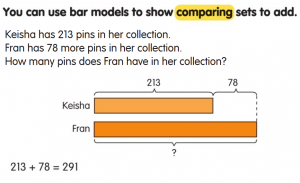 Notice how setting up the model this way shows understanding of what “more than” means. Using our knowledge of the parts-and-total bar model previously taught, it makes it easy for kids to see that what is required to solve this problem is addition.
Notice how setting up the model this way shows understanding of what “more than” means. Using our knowledge of the parts-and-total bar model previously taught, it makes it easy for kids to see that what is required to solve this problem is addition.
The same can be said of using modeling to make sense of “less than” problems:
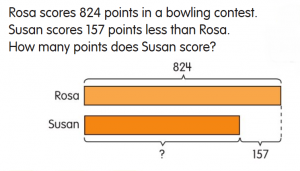 Students who set up the problem correctly can immediately see that Susan’s amount is smaller than Rosa’s, and that subtraction is called for to solve it. Like a parts-and-total frame, we subtract the part (157) from the total (824) to get the remaining part. See how helpful a tool bar modeling is?
Students who set up the problem correctly can immediately see that Susan’s amount is smaller than Rosa’s, and that subtraction is called for to solve it. Like a parts-and-total frame, we subtract the part (157) from the total (824) to get the remaining part. See how helpful a tool bar modeling is?
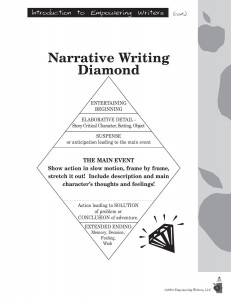 In writing this week, students will learn about the heart of writing narratives: the Main Event. This is where the young author should really stretch out the action and take the reader step-by-step through the event.
In writing this week, students will learn about the heart of writing narratives: the Main Event. This is where the young author should really stretch out the action and take the reader step-by-step through the event.
Consider how a good writer would tell about the following video. Instead of this: “I picked up the bat. The pitcher threw. I hit it,” good writing should sound more like this: “I grabbed the long, wooden bat and swung it up to my shoulder. The pitcher went through his warmup, smacking the ball in his glove to try to shake me. I dug my white high-tops into the dusty ground to show him I meant business.” See how the latter puts the reader in the picture? Try making up your own narrative to go with the video!

